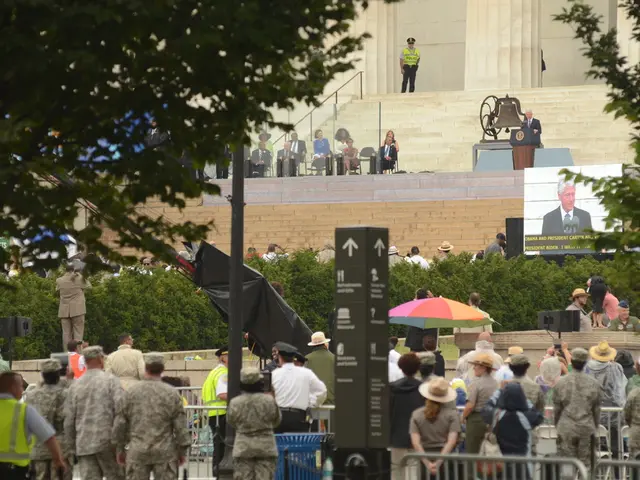Russia deploys a staggering 6,400 unmanned aerial vehicles and missiles towards Ukraine, establishing a new monthly record.
In the ongoing conflict between Russia and Ukraine, drone attacks have become a significant component of Moscow's military campaign. The past month has seen an unprecedented increase in these attacks, with around 6,400 drone and missile sorties launched into Ukraine in July alone - a 13% rise from June [3].
The primary drone model used is the Iranian-designed Shahed strike drone, rebranded by Russia as the Geran. This drone has become emblematic of the Russian drone threat, with its distinctive sound and operational role in harassment and destruction campaigns against Ukrainian cities and infrastructure [3].
Russian forces have launched these drones from multiple directions, including inside Russia and occupied territories such as Crimea and the Rostov and Bryansk regions. For instance, on the night of August 2-3, Russia launched at least 76 Shahed-type and decoy drones, along with several missiles, targeting various locations in Ukraine [2][4]. Despite Ukraine's significant interception rate, many projectiles still arrive with devastating effect, causing damage to critical infrastructure and forcing civilians to seek shelter in bomb shelters and metro stations nightly [3][4].
Ukrainian air defenses have been effective in intercepting many of these threats, having reportedly downed 60 out of 76 drones and intercepting a ballistic missile during this period. However, the mix of strike and decoy drones poses a "very nasty" problem for Ukraine's air defense, tying up manpower and resources [5].
Ukraine has responded with its own drone strikes, targeting Russian military assets. These attacks have caused fires and damage that hamper Moscow's aerial strike capability [1]. However, Ukraine has little ability to affect Russia's growing drone production capability.
The invasion of Ukraine by Russia started more than three years ago, and this drone production capability will have implications for the rest of Europe as well, as Russia will be able to produce and stockpile these weapons in intense numbers [6]. The general consensus among analysts is that Russia's drone production capability will continue to be a major problem, even if the war ends [6].
Furthermore, Western sanctions have not stopped Russian military procurement efforts, as components from Western companies are still found in downed Gerans [6]. The design of the Geran drones has evolved, with some now flying higher, taking tortuous routes to evade Ukrainian defense teams, and using AI targeting systems [6]. The cost of domestically-produced Geran drones ranges from around $10,000 to $50,000 [6].
The impact of these drone attacks includes damage to critical infrastructure such as energy facilities due to concentrated drone strikes, forcing Ukrainians to use bomb shelters and metro stations nightly as protection, reflecting the war's toll on civilian life and urban areas [3][4]. Damage and injury reports indicate that Russian missile and drone strikes have continued to inflict civilian casualties and degrade infrastructure despite Ukrainian air defense efforts [2].
In summary, Russian drone attacks on Ukraine in 2025 are increasingly frequent, sophisticated, and impactful, forming a central part of the conflict’s attritional and psychological warfare, causing ongoing civilian harm and infrastructure damage while Ukraine struggles to defend against them and launch counterstrikes [1][2][3][4]. The escalating drone offensive targeting military and civilian infrastructure presents a significant challenge for Ukraine and raises concerns about the future of the conflict and its impact on European security.
- The escalating drone conflicts in Ukraine, fueled by Russia's growing production capability, has become a critical concern for international human rights groups, as the continuous drone attacks contribute to civilian harm and infrastructure damage.
- As politics between Russia and the West continue to be fraught, the use of drones in war-and-conflicts, such as the one in Ukraine, has become a significant point of discussion in international general news, with concerns about the potential spread of such weapons to other regions.
- The ongoing war between Russia and Ukraine has added another layer to the complex relationship between business and politics, as the development and deployment of drones in militarized conflicts have significant economic implications for nations involved in their production, such as Iran, and those supplying components, often from the West.








